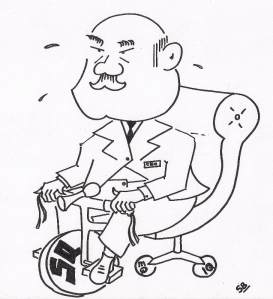
Those exposed to the vicissitudes of a manager’s life often get unduly perturbed about the people around them, or the circumstances and formidable challenges they face in their careers.
But think of it. A manager would strongly protest if another one is made to occupy the office space assigned to her. Why, even a parking space allocation could disturb office harmony! The boss, spending a lot of time with a favourite manager of hers, could create a sense of envy amongst other managers; it could even initiate a chain of rumours and lead to animated discussions at the coffee machine.
Envy, jealousy, hatred, unbridled ambition – all of these happen to be strong undercurrents which could be detected within an outwardly quiet and serene looking manager. Given a chance, managers, like politicians and other professionals, would never cede even a square inch of their turf to someone else.
But if so, one may well ask as to how managers end up permitting others to enter their mental space and cause internal turbulence, often losing a well-earned peaceful sleep at night. They suffer at the hands of a boss or a colleague whom they have come to trust. They get swayed by external circumstances and people, losing their mental equipoise and balance in the process. This obfuscates their vision and disturbs their thinking processes. At times, such negative occurrences even chip off a part of their own self-confidence as well.
Tough bosses routinely rebuke their team members but end up affecting different people differently. Those with a lower self-esteem and a lower Inner Resilience might even contemplate taking a drastic step under external provocation, in some cases leading even to homicidal thoughts. But those who are wired differently might just take such occurrences in their stride, just shrugging off, noticing the underlying lessons and going ahead with the task at hand in a more effective manner.
Higher Inner Resilience is a stress buster
This shows the importance for a manager to have a high degree of Inner Resilience within her mental makeup. This way, she retains her sense of self-esteem. Her perception of reality remains balanced and objective. She is able to punch the right buttons and take better decisions. She owns her actions and takes responsibility for what she does. She does not gloat in a success, attributing it only to her own efforts and initiatives. Nor does she get unduly depressed when faced with failure. The tendency to blame other people or circumstances for her failures does not appeal to her. Instead, a pitiless analysis of the situation at hand gets done. A bout of introspection is attempted.
Her anxiety and stress levels are low. She is more likely to remain in the pink of health. This enables her to live her life to the hilt. An inner bliss is often experienced.
Much like a person who enters the sea for a swim, she is aware that it involves handling mighty waves. Also, that the water is not sweet. So, she is better prepared. Likewise, a manager who possesses a high degree of Inner Resilience is better prepared to handle challenges in her career, whether mighty or otherwise.
In other words, she is smarter than those around herself, better equipped to break the glass ceiling and make it to the higher echelons of an organization.
The risk of Sensitivity
Managers who are sensitive to others’ needs do not necessarily make better bosses. Emotions could cloud their judgement, thereby lowering their level of Inner Resilience. An excess of the Milk of Human Kindness sloshing about in the veins could make them lose their effectiveness as a manager. Moderation is what the doctor would recommend.
However, when Sensitivity gets deployed in tandem with Rational Thought, as drawn from the company’s objectives and policies, they end up being realistically empathic.

Another way of conveying this delicate balance is by the means of a Blake Mouton Grid, which is built upon two dimensions – Concern for People and Concern for Production. Add to this the third dimension – that of Concern for Ethics – and one gets somewhat closer to the quality which the Bhagavad Gita refers to as equipoise.
Learning from Bhagavad Gita
Lord Krishna explains this beautifully to Arjuna. In verse 38 of Chapter 2 of the Bhagavad Gita, He says:
सुखदु:खे समे कृत्वा लाभालाभौ जयाजयौ |
ततो युद्धाय युज्यस्व नैवं पापमवाप्स्यसि || 38||
sukha-duḥkhe same kṛitvā lābhālābhau jayājayau
tato yuddhāya yujyasva naivaṁ pāpam avāpsyasi
‘Having made pleasure and pain, gain and loss, victory and defeat the same, engage in battle for the sake of battle; thus, you shall not incur sin.’

When it comes to understanding the happenings around us, this inner equilibrium is the key facilitator. By attaining this state, a manager can shore up her Spiritual Quotient, of which Inner Resilience is a critical component.
Building up Inner Resilience
Meditative practices help. So does a realization that one is acting as per one’s own conscience and what one believes to be right. In other words, one is following one’s ‘swa-dharma’.
The ability and openness to appreciate a deemed adversary’s view point also helps.
Ignoring people with a negative persona and consciously choosing to remain in the company of some positive thinkers assists.
An attitude of ‘This too shall pass’ helps.
Above all, the wisdom gained from the harsh slings and arrows of Life supports in this endeavour. It follows that introspection helps.
Read Full Post »





















































































